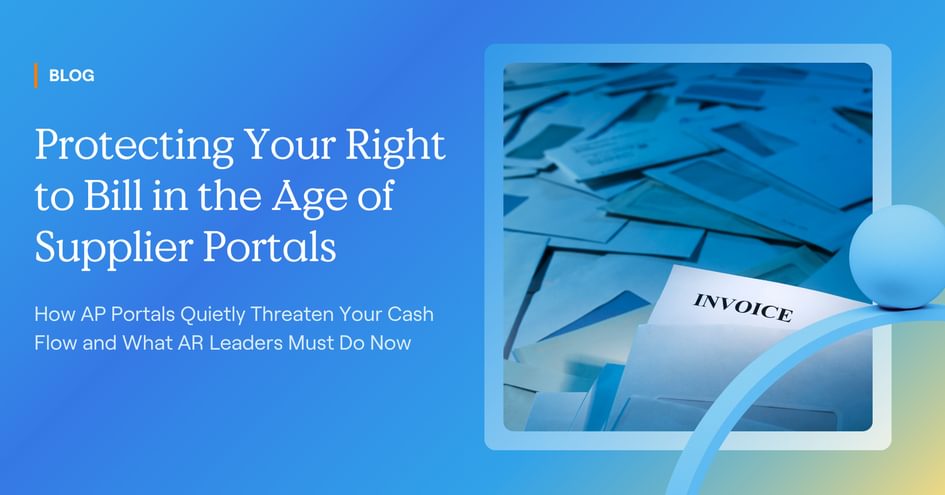Protecting Your Right to Bill in the Age of Supplier Portals

How AP Portals Quietly Threaten Your Cash Flow and What AR Leaders Must Do Now
The Problem: Supplier Portals Introduce New Risks for AR Teams
Supplier portals have rapidly become the default for mid-market and enterprise customers, promising buyers efficiency and control. But for AR teams, these portals are rewriting the rules. The familiar process of emailing invoices or picking up the phone to resolve questions is being replaced by rigid digital workflows. This shift means finance teams must adapt to an environment where each customer may have their own unique set of requirements.
Why Your Right to Bill Is Actually at Risk
Here’s what’s changed: in the past, billing was straightforward. You sent the invoice directly to your customer’s AP team. If there was an issue, you’d get a quick reply, fix it, and move on. Your right to invoice was built into the commercial relationship.
With supplier portals, that process is fundamentally disrupted. Now, you can’t even submit an invoice unless you jump through a series of digital hoops, often without clear instructions or feedback. If you miss any step (wrong PO number, missing attachment, or a required field left blank), the portal rejects your invoice. You may not even find out until days or weeks later.
In other words, your right to bill is now conditional. It’s not enough to have delivered the work or product. Unless you flawlessly navigate every portal requirement, you’re blocked from even starting the clock on payment.
How Net 30 Can Quietly Slips to Net 60
Imagine you complete a project for a customer with Net 30 terms. You upload your invoice to their portal, but unknowingly enter a slightly wrong PO number or forget to attach a required document. The portal silently rejects your invoice. Maybe there’s no automatic notification, so you’re unaware for a week or more.
By the time you’re alerted, you fix the error and resubmit. But now, your “Net 30” clock starts over, not from the project completion date, but from when the corrected invoice is finally accepted. What should have been a 30-day wait is now 60 days or longer, without any change in your contracted terms.
Multiply this by dozens of invoices or multiple portals, and your company’s cash flow is under serious threat.
Lost Visibility, Lost Control
Traditional AR workflows allowed teams to track invoice progress and communicate directly with AP staff. In the portal world, transparency can vanish the moment an invoice is submitted. Status updates may be limited or delayed, and disputes can be raised without timely notification. This lack of visibility turns AR into a guessing game, increasing the administrative burden and undermining cash flow forecasting.
The solution starts with robust documentation, maintaining up-to-date contact lists and escalation paths for each portal customer. Where possible, leverage built-in portal features like status dashboards or automated alerts, and push customers for improved transparency if gaps persist. Integrating portal data into your AR system can empower teams to regain control.
Tiny Mistakes, Cascading Consequences
Supplier portals are not forgiving. One small error—a missing PO, a missed checkbox, an outdated document—can trigger a rejection that resets the payment timeline. These seemingly minor mistakes can have outsized impacts: lost revenue, increased DSO, and hours of unplanned work for your team.
Manual Portal Management: The Hidden Cost
Every new portal brings new logins, new spreadsheets, and new manual processes. AR professionals find themselves spending hours tracking statuses, responding to rejections, and re-entering information. These tasks don’t add value—they drain productivity, delay revenue recognition, and make it nearly impossible to forecast cash flow accurately.
Forward-thinking finance leaders are looking at portal management as a process ripe for automation. By centralizing portal tasks and streamlining workflows, teams can reduce errors, free up capacity for higher-value activities, and improve the overall health of the revenue cycle.
Why You Can’t Afford to Wait
Supplier portals are rapidly multiplying, and requirements are only growing more complex. The longer you wait to address this challenge, the more invoices will pile up in limbo, and the more your DSO and cash flow will suffer. Manual workarounds may get you by in the short term, but they won’t scale as portal adoption accelerates. Finance teams that standardize and automate their portal processes now are securing a competitive advantage—getting paid on time, reducing write-offs, and strengthening their organizations’ financial resilience.
Treating portal compliance as a strategic priority, benchmarking rejection rates and DSO, and building a case for automation are all steps AR leaders can take immediately to turn this challenge into an opportunity.
Automation to the Rescue: How Tesorio Solves the Supplier Portal Problem
Tesorio’s Supplier Portals Agent automates invoice submission, validation, and tracking—eliminating costly errors, speeding up acceptance, and providing real-time visibility across all your portals. With automation, you reclaim your right to bill, protect your invoice terms, and put your team back in the driver’s seat.
Bottom line: Supplier portals aren’t just a technical nuisance for AR—they’re a fast-growing risk to your cash flow and operational efficiency. Addressing them now ensures your right to bill is protected and your business is ready for whatever comes next.
Ready to take back control? Contact us today to learn how we can help you take portals off your plate.